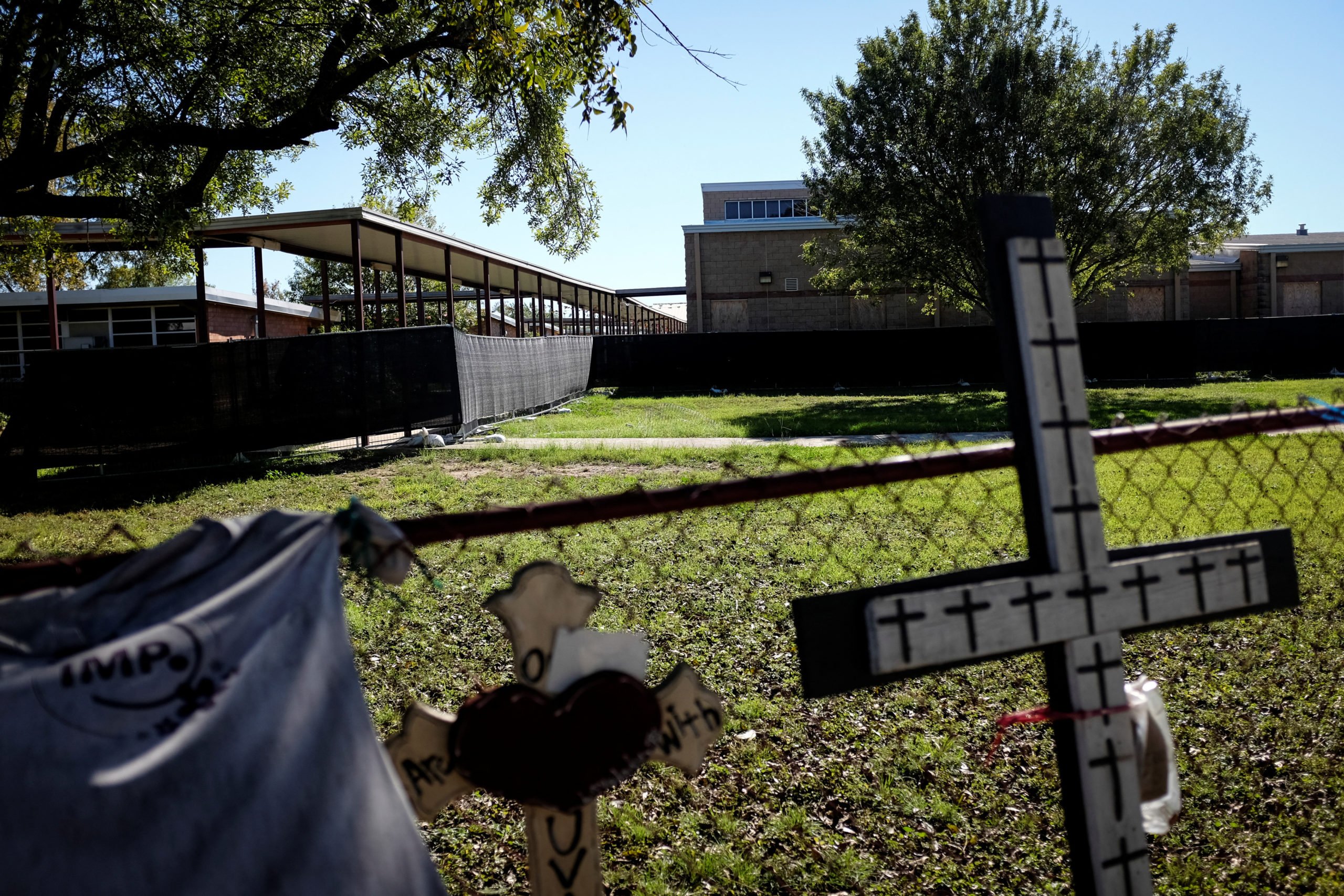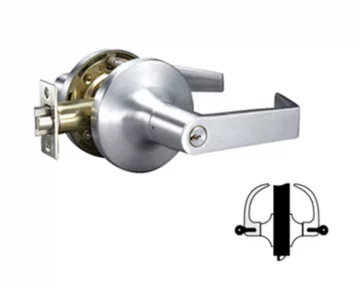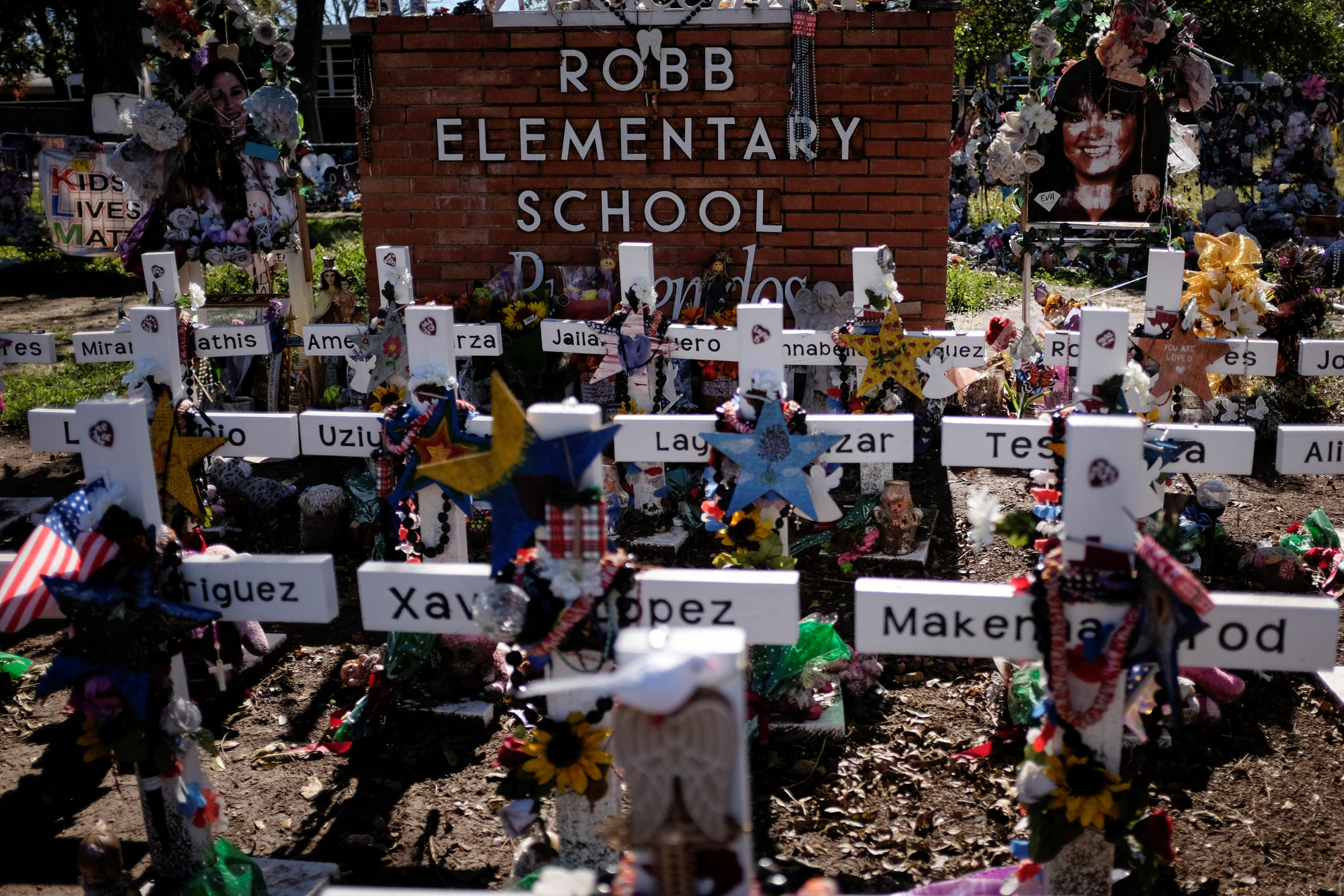In the aftermath of school shootings like the one in Uvalde, what can get overlooked is basic: Schools need doors that work and don’t require special knowledge or keys to secure; they need locks that can be accessed from inside classrooms; and a system for accessing master keys swiftly when minutes matter.
The day of the Robb Elementary School shooting, a teacher had propped open the west exterior door of the school’s west building—added to the school campus 23 years ago—to get food from a colleague, when she saw the shooter heading toward the building. She slammed the door shut, according to the teacher’s attorney, Don Flanary. The door should have kept the shooter out—or at least delayed his entry. It didn’t. Contrary to school policy, all three of the west building’s exterior doors were unlocked that day.
The west building’s exterior doors weren’t the only problem on May 24. Several of the classroom doors had problems latching, including room 111—the classroom through which the shooter “most likely” entered, per the Texas House of Representatives investigation report. KENS5 further reported that the door’s bolt didn’t fit its frame. In addition, Texas Department of Public Safety Director Steven McCraw said that the strike plate that allows the door to latch was damaged.
Whatever the cause, securing the door required extra effort to ensure the latch engaged. Room 111 was not the only classroom whose door had problems. The fourth-grade teacher in room 109 testified in the Texas House report that she also “slammed [her] door shut because otherwise the lock would not [otherwise] latch.”
According to the Texas House report, Arnulfo Reyes, the teacher in Room 111, had alerted school administrators multiple times about the issue with the door prior to May 24. Yet a work order was never issued nor was there documentation of Reyes’ complaint in Robb Elementary maintenance records.
On May 24, across the hall from rooms 111 and 112, in room 105, the fourth-grade teacher stepped into the hallway to ensure her classroom door was locked. She locked eyes with room 112 teacher Irma Garcia, who was also locking her classroom door. Robb Elementary classroom doors and exterior doors could only be locked from the outside.

Doors that require a key are only useful if the keys can be accessed quickly in a crisis. Former Uvalde Consolidated Independent School District (CISD) Police Chief Pedro “Pete” Arredondo, who many thought of as incident commander on May 24—a role he still does not acknowledge—searched frantically for the master key to the classrooms the day of the shooting. Treating the gunman as a barricaded subject rather than an active shooter cost precious time and went against the specialized training Arredondo had received. Arredondo discovered another classroom unlocked and focused on clearing students and teachers, according to CNN. “We’re going to clear out this building before we do any breach,” Arredondo told officers in the hallway at about 12:08 p.m., as heard on body camera footage.
Body camera footage of Uvalde Police Sargent Daniel Coronado released by USA Today and edited by the Uvalde Police Department shows repeated attempts to find the master key. First, Arredondo tried a set of keys on room 109 at 12:18; at 12:30, another officer has a lanyard with a big ring of keys he begins testing on room 108. With stacks of keys on the ground, the officer continued searching for the master key. At 12:33, Arredondo can be heard saying, “If we get a key, it would take a second to open that goddamned door.”
Uvalde CISD police Lieutenant Mike Hernandez carried more than 50 keys with him. These were sent to the west building on the day of the shooting, but officers could not identify the correct one, according to the Texas House report.
In fact, there was no single master key. Robb Elementary was built in 1955, and the west building was newer. According to Hernandez, staff would also change locks without notifying him.
Elsewhere in the west building, U.S. Border Patrol Tactical Unit (BORTAC) Acting Commander Paul Guerrero received a master key, testing it out on an adjacent classroom door before venturing to room 111, where the shooter was barricaded. The key didn’t work. Later, he received a second master key, which he successfully used to open the door, according to a statement by Guerrero, before heading to unlock room 111 and eliminate the shooter. The question remains: Was the door to room 111 locked?
According to the $27 billion class action lawsuit filed on behalf of surviving families and against Uvalde CISD and other defendants, “Guerrero told the students in room 111 to yell through the door if they needed help and the shooter shot the responding student as BORTAC opened the door and eliminated the shooter.”
Part of the reason doors were propped open or left unlocked was because of a key shortage. The manufacturer had discontinued production of the door locks used at Robb; the school district had acquired a supply of key blanks, but those were gone by May 2022, Uvalde CISD Maintenance & Operations Director Rodney Harrison said in the Texas House report. Because of the key shortage, substitute teachers were told to use magnets and other methods to get around the locks in violation of school district policy.
According to 5,100 responses from Texas teachers, school employees, parents, and community members polled for a Texas American Federation of Teachers survey in June 2022, 90 percent of Texas school employees have worried about a shooting at their school and 96 percent agreed on the need to increase education funding to protect schools.
“We have had two decades of a lot of tragic learning opportunities—why are we still in this situation,” said Nicole Hill, director of communications for Texas American Federation of Teachers. “Texas averages about five school shootings a year for the past 20 years, how are we still having this conversation? When do we realize that underfunding our schools is a safety issue?”
The Sandy Hook Advisory Commission Final Report made a jarring if straightforward observation in its report on the shooting at Sandy Hook, which claimed the lives of 26 victims: “There has never been an event in which an active shooter breached a locked classroom door.”

After the mass shooting at Columbine High School in Colorado in 1999, Jeffco Public Schools, which counts Columbine as one of its campuses, changed its classroom door locks to include an internal push button locking mechanism. Commonly called “Columbine locks,” they can be locked from the inside and don’t require a key, a special tool, or special knowledge to secure.
“So [from the] interior, they shut the door, push a button, and it automatically locks,” said Jeff Pierson, executive director of school safety for Jeffco Public Schools. “When you think about a traumatic event, your motor skills often tend to go away and are not very useful, so having to pull a key out of your pocket or around your neck and actually put it into a slot to lock the door during a traumatic event can cause major issues as well.”
Master keys need to be rapidly accessed in an emergency. This is what the KnoxBox is all about. Used by first responders, KnoxBox units are installed in central locations that can be quickly accessed in case of emergency by fire or police departments. The company’s lockbox system is used by 15,000 fire departments, according to Mark Debban, KNOX sales leader. Police departments and schools use them too.

These lockboxes for rapid retrieval of master keys are utilized at almost all 120 Northside ISD schools in San Antonio, added initially as a preventative action to fight fires in schools. They are now required by city and municipality protocols, said Leroy San Miguel, facilities manager of Northside ISD. When a new building or addition goes up, the city requires KnoxBoxes. Demand for the lockboxes is so high, “There’s a backlog of just getting the box. Out of 120 schools, we’ve got maybe 20 schools that we’re waiting for the shipment to come in, so that as soon as they get in our maintenance department and carpenters are going to go install them right away.”
The Partner Alliance for Safer Schools lays out best practices, vetted by experts across education, public safety, and industry sectors in a School Safety and Security Checklist. First item in the access control section for school district recommendations: “emergency building access system for fire/emergency/law enforcement (rapid access credential vault)” for all four tiers of schools that range from basic (tier 1) to advanced security and safety systems (tier 4). Then, for tiers three and four, a recommendation “all command staff possess keys and/or access credentials.”
The best door defense to keep out intruders can be circumvented by rocks propping open a door or a magnet that prevents a lock from working. The Texas House report and the recent $27 billion class action lawsuit filed by a group of plaintiff survivors—children and their caregivers, along with school staff—note the noncompliance that plagued Robb Elementary School. But ensuring all classroom and exterior doors and their locks work as they should is a basic line of defense missing oversight.
“School safety protocols are designed to keep schools safe and secure. It’s up to everybody to know what those verticals are and to be trained on how to do them and to identify when things are not working right, and report them,” said Tim Miller, executive director of the nonprofit Uvalde CISD Moving Forward Foundation. “It’s important to have protocols and then to make sure people know what they are and to implement them.”
“School safety protocols keep schools safe and secure. It’s up to everybody to be trained on how to use them and, when things are not working right, to report them.”
Robb Elementary School will be razed. A new school will be built two miles away. The Uvalde CISD Moving Forward Foundation is responsible for pulling in funds for constructing the new school and recently revealed architectural renderings of it, noting security features including keyless entry points which, depending on the kind of lock, could provide complications similar to keys. The foundation is not associated with Uvalde CISD.
Funding to upgrade school security can get pricey. After the 2018 Santa Fe High School shooting that left 10 dead, the state of Texas issued a $100 million grant to Texas school districts in 2019, including Uvalde CISD, to shore up security. With 1,026 public school districts, that amount didn’t stretch far enough. Uvalde received only $69,000 according to NBC News.
In 2019, the Texas Legislature passed Senate Bill 11 linked to policies, procedures, and measures for school safety and mental health promotion in public schools. In 2022, $48 million was issued to school systems, the amount given to the school district contingent on each student in average daily attendance. The funds can be used for improving school safety and include improvements to school infrastructure. On November 3, 2022, the Texas Education Agency announced proposed school safety standards that included a rule requiring all school system instructional facilities to have “access points that are secured by design, maintained to operate as intended, and appropriately monitored.” This would be tied with a formula-based grant application for public schools that is now open.
As reported in the Texas Tribune, Uvalde is set to receive $442,000 from the Department of Justice Office of Community-Oriented Policing Services from a gun safety law passed last summer. The grants will be spread out to 27 other Texas school districts for a total of $8 million.
At the end of last October, the state announced an additional amount of $874.6 million for public safety and school safety by the Legislative Budget Board to be transferred to state agencies and programs. That includes $400 million to assist school districts in replacing or upgrading doors and other facility safety measures.
Bonds are another way of implementing needed security upgrades for schools, which can be problematic in tough economic times.

“Property taxes are soaring, and it’s a harder sell a lot of times, even when the bonds are super-necessary,” Texas AFT’s Hill said. “The bigger issue with this comes back to we are at the bottom of every education funding list nationally. We are 44th for per-student spending.”
During the 2022 midterm elections, school safety improvements were tied into bond propositions across Texas, with bond packages in Judson ISD, Austin ISD, Plano ISD, Angleton ISD, Texas City ISD, and Lamar CISD being voted in. When tallied up, those bond proposition packages, approved by voters, came to $6.2 billion—included in that sum, the $1.5 billion bond for Lamar CISD, which is the largest to pass in the district’s history.
The Uvalde Leader-News reported in April 2022 that Uvalde CISD was in the process of pulling together a bond proposal for the November election, following a 2020 and 2021 Texas Association of School Boards facility study that revealed it would cost $70 million to repair Uvalde CISD school facilities. After the tragedy at Robb Elementary last May, the bond never made it to the ballot.
Some communities get behind bond measures regularly. Northside ISD has been able to replace hardware in its schools through multiple bond measures that have passed in recent years.
“We decided to change the hardware completely,” said San Miguel. “We did it over two or three bond programs—you can imagine—over 29,000 doors, and we have older schools and newer schools.”
San Miguel said pushing for greater security is an easy sell.
“If it’s safety and security, [communities] want more,” he said. “They don’t say, ‘Why are you spending $3 million on this or on that?’ There’s never a question. It’s usually ‘Do more.’”
In Jeffco Public Schools, Pierson said the district used money from bonds and one of their grants to fund some of the replacements of classroom door locks—with the majority on a need and must-need basis from their facilities department.
Hill said that getting the funding is only step one, but equally as important is to get input from the teachers, staff, and parents on how the money should be used since they often know the buildings better than school administrators and politicians.
“Often, these huge or not huge sums of money go into our school districts, they are allotted for vague safety upgrades and decisions get made at a level of school board or higher, of admins or higher. And the people on the ground know that ‘oh, this particular building has a real problem and the doors are busted on this end or we always have an issue on this campus’—they’re not consulted,” Hill said. “So, we end up spending a lot of money on solving a problem and maybe we didn’t really solve it?”
Often, huge sums of money go into our school districts and are allotted for vague safety upgrades. Decisions get made at a level of the school board or higher—those on campus day to day are never consulted.
2022 turned out to be a deadly year for school shootings as the EducationWeek school shooting tracker cited the most shootings in a single year since they started tracking them in 2018. In 2022, 51 school shootings occurred in K-12 that resulted in injuries or death—seven of which happened while writing and revising this article. An illustration on the tracker shows how the shootings polka dot across the map of the United States. Replacing classroom doors with exterior locks with ones that lock inside isn’t a silver bullet, but it can provide quick access to secure students and their teachers in traumatic situations.
The Texas House report: “Locking the exterior and interior doors ultimately may not have been enough to stop the attacker from entering the building and classrooms [in Uvalde]. But had school personnel locked the doors as the school’s policy required, that could have slowed his progress for a few precious minutes—long enough to receive alerts, hide children, and lock doors.”







